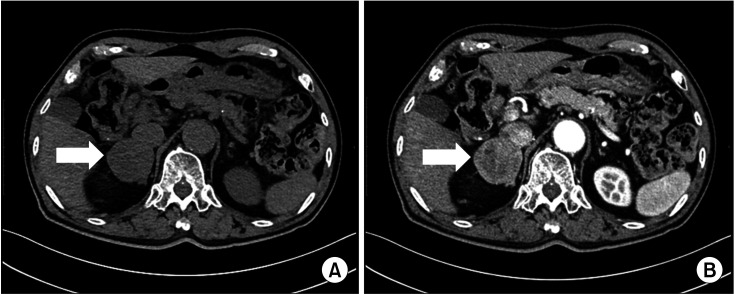Ann Surg Treat Res.
2024 Jan;106(1):38-44. 10.4174/astr.2024.106.1.38.
Silent pheochromocytoma in adrenal incidentaloma: unveiling clinical and radiological characteristics
- Affiliations
-
- 1Department of Surgery, Asan Medical Center, University of Ulsan College of Medicine, Seoul, Korea
- 2Department of Radiology, Asan Medical Center, University of Ulsan College of Medicine, Seoul, Korea
- KMID: 2550249
- DOI: http://doi.org/10.4174/astr.2024.106.1.38
Abstract
- Purpose
Silent pheochromocytoma refers to tumors without signs and symptoms of catecholamine excess. This study aimed to clarify the clinical, radiological characteristics, and perioperative features of silent pheochromocytomas diagnosed after adrenalectomy for adrenal incidentaloma.
Methods
Medical records of patients who underwent adrenalectomy for adrenal incidentaloma and were subsequently diagnosed with silent pheochromocytoma between January 2000 and December 2020 were retrospectively reviewed for demographic, diagnostic, surgical, and pathological findings.
Results
Of the 130 patients who underwent adrenalectomy for incidentaloma, 8 (6.1%) were diagnosed with silent pheochromocytoma. Almost all patients had no hypertensive symptoms and their baseline hormonal levels remained within normal ranges. All patients exhibited tumor size >4 cm, precontrast Hounsfield unit >10, and absolute washout <60%. Intraoperative hypertensive events were noted in 2 patients (25.0%) in whom antiadrenergic medications were not administered. All patients in the intraoperative hypertensive event group exhibited atypical features on CT, whereas 83.3% of patients in the non-intraoperative hypertensive event group showed atypical features on CT imaging.
Conclusion
Silent pheochromocytomas share radiological traits with malignant adrenal tumors. Suspicious features on CT scans warrant surgical consideration for appropriate treatment. Administering alpha-blockers can enhance hemodynamic stability during adrenalectomy in suspected silent pheochromocytoma cases.
Figure
Reference
-
1. Tischler AS, Pacak K, Eisenhofer G. The adrenal medulla and extra-adrenal paraganglia: then and now. Endocr Pathol. 2014; 25:49–58. PMID: 24362581.
Article2. Kasperlik-Zaluska AA, Roslonowska E, Slowinska-Srzednicka J, Otto M, Cichocki A, Cwikla J, et al. 1,111 patients with adrenal incidentalomas observed at a single endocrinological center: incidence of chromaffin tumors. Ann N Y Acad Sci. 2006; 1073:38–46. PMID: 17102070.3. Salmenkivi K, Heikkilä P, Haglund C, Arola J. Malignancy in pheochromocytomas. APMIS. 2004; 112:551–559. PMID: 15601303.4. Cotesta D, Petramala L, Serra V, Pergolini M, Crescenzi E, Zinnamosca L, et al. Clinical experience with pheochromocytoma in a single centre over 16 years. High Blood Press Cardiovasc Prev. 2009; 16:183–193. PMID: 23334910.5. Anderson GH Jr, Blakeman N, Streeten DH. The effect of age on prevalence of secondary forms of hypertension in 4429 consecutively referred patients. J Hypertens. 1994; 12:609–615. PMID: 7930562.6. Zarco-González JA, Herrera MF. Adrenal incidentaloma. Scand J Surg. 2004; 93:298–301. PMID: 15658671.7. Spiro A, Usman A, Ajmal A, Hoang TD, Shakir MK. Asymptomatic and biochemically silent pheochromocytoma with characteristic findings on imaging. Case Rep Endocrinol. 2020; 2020:8847261. PMID: 33062351.8. Li C, Chen Y, Wang W, Teng L. A case of clinically silent giant right pheochromocytoma and review of literature. Can Urol Assoc J. 2012; 6:E267–E269. PMID: 23283101.9. Gupta A, Bains L, Agarwal MK, Gupta R. Giant cystic pheochromocytoma: a silent entity. Urol Ann. 2016; 8:384–386. PMID: 27453669.10. Lee JA, Zarnegar R, Shen WT, Kebebew E, Clark OH, Duh QY. Adrenal incidentaloma, borderline elevations of urine or plasma metanephrine levels, and the “subclinical” pheochromocytoma. Arch Surg. 2007; 142:870–874. PMID: 17875842.11. Andreoni C, Krebs RK, Bruna PC, Goldman SM, Kater CE, Alves MT, et al. Cystic phaeochromocytoma is a distinctive subgroup with special clinical, imaging and histological features that might mislead the diagnosis. BJU Int. 2008; 101:345–350. PMID: 18070168.12. Antedomenico E, Wascher RA. A case of mistaken identity: giant cystic pheochromocytoma. Curr Surg. 2005; 62:193–198. PMID: 15796940.13. El-Doueihi RZ, Salti I, Maroun-Aouad M, El Hajj A. Bilateral biochemically silent pheochromocytoma, not silent after all. Urol Case Rep. 2019; 24:100876. PMID: 31211085.14. Farrugia FA, Martikos G, Tzanetis P, Charalampopoulos A, Misiakos E, Zavras N, et al. Pheochromocytoma, diagnosis and treatment: review of the literature. Endocr Regul. 2017; 51:168–181. PMID: 28858847.15. Sung TY. A case of incidentally detected silent adrenal pheochromocytoma, mimicking as an intraperitoneal tumor with unusual computed tomography findings. J Endocr Surg. 2023; 23:80–84.16. Yang H, Wu HH, Bu N, Zhou L, Zhang JQ, Zhou LQ, et al. Clinical characteristics of silent pheochromocytoma. Zhonghua Yi Xue Za Zhi. 2018; 98:2727–2731. PMID: 30220169.17. Thompson LD. Pheochromocytoma of the Adrenal gland Scaled Score (PASS) to separate benign from malignant neoplasms: a clinicopathologic and immunophenotypic study of 100 cases. Am J Surg Pathol. 2002; 26:551–566. PMID: 11979086.18. Szolar DH, Kammerhuber FH. Adrenal adenomas and nonadenomas: assessment of washout at delayed contrast-enhanced CT. Radiology. 1998; 207:369–375. PMID: 9577483.19. Kebebew E. Adrenal incidentaloma. N Engl J Med. 2021; 384:1542–1551. PMID: 33882207.20. Zilberman DE, Drori T, Shlomai G, Mazeh H, Fishman B, Golan S, et al. Adrenal ganglioneuroma resected for suspicious malignancy: multicenter review of 25 cases and review of the literature. Ann Surg Treat Res. 2021; 101:79–84. PMID: 34386456.21. Kloos RT, Gross MD, Francis IR, Korobkin M, Shapiro B. Incidentally discovered adrenal masses. Endocr Rev. 1995; 16:460–484. PMID: 8521790.22. Mannelli M, Lenders JW, Pacak K, Parenti G, Eisenhofer G. Subclinical phaeochromocytoma. Best Pract Res Clin Endocrinol Metab. 2012; 26:507–515. PMID: 22863392.23. Isaacs M, Lee P. Preoperative alpha-blockade in phaeochromocytoma and paraganglioma: is it always necessary? Clin Endocrinol (Oxf). 2017; 86:309–314. PMID: 27864838.24. Kota SK, Kota SK, Panda S, Modi KD. Pheochromocytoma: an uncommon presentation of an asymptomatic and biochemically silent adrenal incidentaloma. Malays J Med Sci. 2012; 19:86–91. PMID: 22973143.25. Wachtel H, Hutchens T, Baraban E, Schwartz LE, Montone K, Baloch Z, et al. Predicting metastatic potential in pheochromocytoma and paraganglioma: a comparison of PASS and GAPP scoring systems. J Clin Endocrinol Metab. 2020; 105:e4661–e4670. PMID: 32877928.
- Full Text Links
- Actions
-
Cited
- CITED
-
- Close
- Share
- Similar articles
-
- A Case of Incidentally Detected Silent Adrenal Pheochromocytoma, Mimicking as an Intraperitoneal Tumor With Unusual Computed Tomography Findings
- Characterization of Incidentally Detected Adrenal Pheochromocytoma
- A Case of Incidentaloma Compromising of Pheochromocytoma and Adrenocortical Adenoma in an Infant
- A Case of Malignant Pheochromocytoma
- Adrenal incidentaloma: a case of asymptomatic pheochromocytoma


